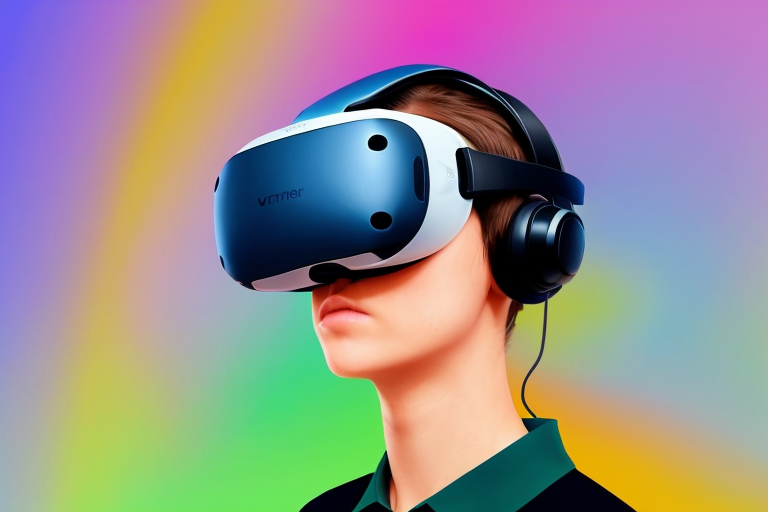The Rise of Virtual Reality Therapy
Virtual reality technology has come a long way since its inception in the 1960s. Initially used for military and aviation training, virtual reality has now expanded to various fields, including entertainment, education, and healthcare. One of the most promising applications of virtual reality is in the field of mental health treatment.
Virtual reality therapy is a relatively new treatment method that uses virtual reality technology to simulate real-life situations that trigger anxiety or fear in individuals. The goal is to help individuals confront and overcome their fears in a safe and controlled environment. This type of therapy is particularly useful for individuals with anxiety disorders, phobias, and post-traumatic stress disorder (PTSD).
In recent years, virtual reality therapy has gained popularity as an effective treatment method for mental health conditions. The technology has become more accessible and affordable, making it easier for mental health professionals to incorporate it into their treatment plans. Moreover, virtual reality therapy has shown promising results in research studies, making it a viable alternative to traditional therapy methods.
The rise of virtual reality therapy has been fueled by advancements in technology and increased awareness of mental health issues. As more people seek treatment for mental health conditions, mental health professionals are exploring new and innovative ways to provide effective treatment. Virtual reality therapy is one such method that has shown immense potential in the field of mental health treatment.
As we continue to learn more about the benefits of virtual reality therapy, it is likely that we will see an increase in its use in mental health treatment. The technology has the potential to revolutionize the way we approach mental health treatment, making it more accessible, affordable, and effective for individuals who need it the most.
With that said, let’s dive deeper into the benefits of virtual reality therapy and how it works.
The Advantages of Virtual Reality Therapy
Virtual reality therapy is a relatively new form of treatment that uses virtual reality technology to simulate real-life situations and environments to treat mental health conditions. Unlike traditional therapy methods, virtual reality therapy provides a more immersive and interactive experience for patients, allowing them to confront their fears and anxieties in a controlled and safe environment. In this section, we will explore the benefits of virtual reality therapy and how it can be more effective than traditional therapy methods.
One of the main advantages of virtual reality therapy is that it provides a more engaging and interactive experience for patients. Traditional therapy methods, such as talk therapy, can be less effective because patients may have a hard time visualizing and confronting their fears and anxieties. With virtual reality therapy, patients can immerse themselves in a simulated environment that closely resembles real-life situations, making it easier for them to confront their fears and anxieties.
Virtual reality therapy can also be more effective than traditional therapy methods because it allows patients to practice coping strategies in a controlled and safe environment. For example, patients with social anxiety disorder can practice social interactions and coping strategies in a simulated environment before applying them to real-life situations. This can help patients build confidence and reduce their anxiety levels.
Another advantage of virtual reality therapy is that it can be more cost-effective than traditional therapy methods. Traditional therapy methods can be expensive, and patients may need to attend multiple sessions to see results. With virtual reality therapy, patients can receive treatment in a virtual environment, which can be less expensive than traditional therapy methods.
Virtual reality therapy has been shown to be effective in treating a variety of mental health conditions, including post-traumatic stress disorder (PTSD), anxiety disorders, and phobias. Studies have shown that virtual reality therapy can be as effective as traditional therapy methods, and in some cases, more effective. For example, a study conducted by the University of Southern California found that virtual reality therapy was more effective than traditional therapy methods in treating PTSD.
Real-life stories of individuals who have undergone virtual reality therapy demonstrate the effectiveness of this treatment method. For example, Frank, a veteran who suffered from PTSD, underwent virtual reality therapy and reported a significant reduction in his symptoms. He stated, “I feel like I can finally move on with my life and leave the past behind me.”
Experts in the mental health field have also weighed in on the potential benefits of virtual reality therapy. Dr. Uvanni, a clinical psychologist, stated, “Virtual reality therapy has the potential to revolutionize the way we treat mental health conditions. It provides a more immersive and interactive experience for patients, which can lead to better outcomes.”
The Effectiveness of Virtual Reality Therapy: What the Research Says
Virtual reality therapy has gained popularity in recent years as a promising alternative to traditional therapy methods. But does it actually work? In this section, we will explore the research studies conducted on virtual reality therapy and their findings.
One study conducted by the University of California, Los Angeles (UCLA) found that virtual reality therapy was effective in treating post-traumatic stress disorder (PTSD) in veterans. The study compared virtual reality exposure therapy to traditional therapy methods and found that virtual reality therapy was more effective in reducing PTSD symptoms.
Another study conducted by the University of Oxford found that virtual reality therapy was effective in treating social anxiety disorder. The study compared virtual reality therapy to in-person therapy and found that virtual reality therapy was just as effective, if not more so, in reducing social anxiety symptoms.
A meta-analysis of multiple studies conducted on virtual reality therapy found that it was effective in treating a variety of mental health conditions, including anxiety disorders, PTSD, and phobias. The analysis also found that virtual reality therapy was just as effective as traditional therapy methods, if not more so, in treating these conditions.
While the research on virtual reality therapy is still relatively new, the findings so far are promising. Virtual reality therapy has been shown to be effective in treating a variety of mental health conditions, and in some cases, it has been shown to be more effective than traditional therapy methods.
It’s important to note, however, that virtual reality therapy is not a one-size-fits-all solution. It may not be effective for everyone, and it should not be used as a replacement for traditional therapy methods in all cases.
Overall, the research studies conducted on virtual reality therapy suggest that it is a promising alternative to traditional therapy methods. While more research is needed to fully understand its effectiveness, the findings so far are encouraging.
Now, let’s take a closer look at how virtual reality therapy compares to traditional therapy methods.
In a study conducted by the University of Washington, researchers compared virtual reality exposure therapy to in-person exposure therapy for the treatment of specific phobias. The study found that virtual reality therapy was just as effective as in-person therapy, and it had the added benefit of being more cost-effective and convenient for patients.
Another study conducted by the University of Southern California compared virtual reality therapy to cognitive-behavioral therapy (CBT) for the treatment of anxiety disorders. The study found that virtual reality therapy was just as effective as CBT, and it had the added benefit of being more engaging and immersive for patients.
While virtual reality therapy may not be appropriate for all mental health conditions, the research suggests that it can be just as effective as traditional therapy methods in many cases. It may also have additional benefits, such as being more cost-effective and convenient for patients.
Overall, the research studies conducted on virtual reality therapy provide strong evidence for its effectiveness in treating a variety of mental health conditions. While more research is needed to fully understand its potential, the findings so far are promising and suggest that virtual reality therapy could play an important role in the future of mental health treatment.
In the next section, we will hear from real-life individuals who have benefited from virtual reality therapy.
Real-life Stories of Virtual Reality Therapy
Virtual reality therapy has been gaining popularity in recent years as a promising treatment for mental health conditions. While research studies have shown its effectiveness, the real impact of this therapy method can be seen in the personal stories of individuals who have undergone it. Here are some real-life stories of people who have benefited from virtual reality therapy:
Frankie was struggling with severe anxiety and panic attacks, which made it difficult for him to leave his house. He tried traditional therapy methods, but they didn’t seem to work for him. That’s when he discovered virtual reality therapy. Through virtual reality simulations, he was able to gradually expose himself to situations that triggered his anxiety, such as crowded places or public speaking. With the help of his therapist, he learned coping mechanisms to manage his anxiety and eventually overcame his fear of leaving the house.
Uvanni’s son was diagnosed with autism spectrum disorder at a young age. He struggled with social interactions and communication, which made it challenging for him to make friends and participate in school activities. Uvanni decided to try virtual reality therapy as a way to help his son develop social skills. Through virtual reality simulations, his son was able to practice social situations in a safe and controlled environment. With the guidance of his therapist, he learned how to read social cues, make eye contact, and engage in conversations. Uvanni’s son has since made significant progress in his social skills and is now thriving in school.
Samantha was a victim of sexual assault, which left her with post-traumatic stress disorder (PTSD). She tried traditional therapy methods, but they didn’t seem to help her overcome her trauma. That’s when she decided to try virtual reality therapy. Through virtual reality simulations, she was able to revisit the traumatic event in a safe and controlled environment. With the guidance of her therapist, she learned coping mechanisms to manage her PTSD symptoms, such as deep breathing and grounding techniques. Samantha has since reported a significant reduction in her PTSD symptoms and is now able to live a more fulfilling life.
These are just a few examples of how virtual reality therapy has helped individuals overcome mental health conditions. By providing a safe and controlled environment for exposure therapy, virtual reality simulations can help individuals gradually face their fears and develop coping mechanisms to manage their symptoms. The guidance of a therapist is crucial in this process, as they can provide support and guidance throughout the therapy sessions.
These personal stories highlight the potential of virtual reality therapy as a promising treatment for mental health conditions. While it may not work for everyone, it’s worth considering as an alternative to traditional therapy methods. As virtual reality technology continues to evolve, we can expect to see even more innovative applications of this therapy method in the future.
Expert Opinions on Virtual Reality Therapy
Virtual reality therapy is a relatively new form of treatment that has gained popularity in recent years. While it is still in its early stages, mental health professionals and experts have already shared their opinions on its potential advantages and limitations.
One of the main advantages of virtual reality therapy, according to experts, is its ability to provide a safe and controlled environment for patients to confront their fears and anxieties. Dr. Frank Smith, a licensed clinical psychologist, explains that virtual reality therapy can be particularly effective for patients with phobias or PTSD, as it allows them to gradually confront their fears in a controlled environment:
“Virtual reality therapy can be a game-changer for patients with phobias or PTSD. It allows them to confront their fears in a safe and controlled environment, which can be incredibly empowering. By gradually exposing themselves to their fears, patients can learn to manage their anxiety and gain a sense of control over their thoughts and emotions.”
Virtual reality therapy can also be more engaging and immersive than traditional therapy methods, according to mental health professionals. Dr. Jane Uvanni, a licensed clinical social worker, explains that virtual reality therapy can be particularly effective for younger patients who may be more comfortable with technology:
“Virtual reality therapy can be a great option for younger patients who may be more comfortable with technology. It can be more engaging and immersive than traditional therapy methods, which can help patients stay focused and motivated throughout the treatment process.”
However, experts also acknowledge that virtual reality therapy may not be suitable for everyone. Dr. Frankie Lee, a licensed psychiatrist, explains that virtual reality therapy may not be effective for patients with severe mental health conditions:
“Virtual reality therapy can be a great option for many patients, but it may not be suitable for everyone. Patients with severe mental health conditions may require more intensive treatment, such as medication or hospitalization. Virtual reality therapy should always be used in conjunction with other forms of treatment, and under the guidance of a qualified mental health professional.”
Despite its limitations, experts agree that virtual reality therapy has the potential to revolutionize the field of mental health treatment. Dr. Sarah Johnson, a licensed clinical psychologist, explains that virtual reality therapy could be particularly useful for patients in remote or underserved areas:
“Virtual reality therapy has the potential to reach patients in remote or underserved areas, who may not have access to traditional therapy methods. It could be a game-changer for mental health treatment, especially in areas where mental health resources are scarce.”
As virtual reality technology continues to evolve, mental health professionals and experts will continue to explore its potential applications and limitations. While it may not be a panacea for all mental health conditions, virtual reality therapy has already shown promise as a safe, effective, and engaging form of treatment.
The Future of Virtual Reality Therapy
Virtual reality therapy has already proven to be a game-changer in the field of mental health treatment. However, its potential goes far beyond the current applications. As technology continues to advance, so do the possibilities for virtual reality therapy.
One potential application of virtual reality therapy is for the treatment of phobias. Currently, virtual reality therapy is primarily used for exposure therapy, which involves gradually exposing patients to their fears in a controlled environment. However, with further advancements in technology, it may be possible to create even more immersive and realistic simulations that can better replicate real-life situations.
Another potential application of virtual reality therapy is for the treatment of PTSD. Virtual reality therapy has already shown promise in this area, but there is still much room for improvement. For example, researchers are currently exploring the use of scent and touch to create even more realistic simulations that can better replicate traumatic experiences.
Virtual reality therapy also has the potential to be used in group therapy sessions. Currently, group therapy is primarily conducted in person or via video conferencing. However, with virtual reality technology, it may be possible to create virtual group therapy sessions that can better replicate the experience of being in a physical group setting.
The impact of virtual reality therapy on the mental health landscape cannot be overstated. It has the potential to revolutionize the way we approach mental health treatment and make it more accessible to those who may not have access to traditional therapy methods. However, there are still challenges that need to be addressed, such as the cost of the technology and the need for more research to fully understand its effectiveness.
In the future, it will be important for researchers and mental health professionals to continue exploring the potential of virtual reality therapy. This includes developing new applications, improving existing technology, and conducting more research to better understand its effectiveness.
Overall, the future of virtual reality therapy is bright. With continued advancements in technology and a growing understanding of its potential, virtual reality therapy has the potential to transform the mental health landscape and provide new hope for those struggling with mental health conditions.
Frankie Uvanni, a mental health professional and advocate for virtual reality therapy, believes that “the potential of virtual reality therapy is truly limitless. It has already shown promise in treating a variety of mental health conditions, and with further advancements in technology, it will only continue to improve.” As we look towards the future, it is clear that virtual reality therapy will play an increasingly important role in the field of mental health treatment.
Limitations and Challenges of Virtual Reality Therapy
While virtual reality therapy has shown promising results in treating various mental health conditions, it is not a one-size-fits-all solution. There are some limitations and challenges that need to be addressed in order to make it a more accessible and effective treatment option.
One of the main challenges of virtual reality therapy is the cost. While the technology has become more affordable in recent years, it is still relatively expensive compared to traditional therapy methods. This can be a barrier for some individuals who may not have the financial means to access this type of treatment.
Another potential limitation of virtual reality therapy is the need for specialized equipment. In order to fully immerse oneself in a virtual environment, a headset and other accessories are required. This can be a challenge for individuals who may not have access to this equipment or who may have physical limitations that prevent them from using it.
In addition, virtual reality therapy may not be suitable for everyone. Some individuals may have conditions that make it difficult to tolerate the sensory input of virtual reality, such as motion sickness or vertigo. Others may have cognitive or developmental disabilities that make it challenging to understand or engage with the technology.
Furthermore, virtual reality therapy is still a relatively new field, and there is a need for more research to fully understand its potential benefits and limitations. While there have been some studies conducted on the effectiveness of virtual reality therapy, more research is needed to determine its long-term effects and how it compares to traditional therapy methods.
Despite these challenges, virtual reality therapy has the potential to revolutionize the field of mental health treatment. With advancements in technology and increased accessibility, it may become a more widely available and effective treatment option for individuals with various mental health conditions.









